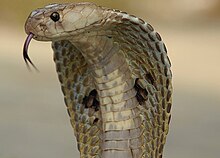| CobraInformal name for various snakesTemporal range: Miocene–Holocene | |
|---|---|

| |
| Indian cobra (Naja naja) | |
| Scientific classification | |
| Domain: | Eukaryota |
| Kingdom: | Animalia |
| Phylum: | Chordata |
| Class: | Reptilia |
| Order: | Squamata |
| Clade: | Ophidia |
| Suborder: | Serpentes |
| Subdivisions | |
| |
Cobra is the common name of various venomous snakes, most of which belong to the genus Naja.
Many cobras are capable of rearing upwards and producing a hood when threatened.
Other snakes known as "cobras"
While the members of the genus Naja constitute the true cobras, the name cobra is also applied to these other genera and species:
- The rinkhals, ringhals or ring-necked spitting cobra (Hemachatus haemachatus) so-called for its neck band as well as its habit of rearing upwards and producing a hood when threatened
- The king cobra or hamadryad (Ophiophagus hannah)
- The two species of tree cobras, Goldie's tree cobra (Pseudohaje goldii) and the black tree cobra (Pseudohaje nigra)
- The two species of shield-nosed cobras, the Cape coral snake (Aspidelaps lubricus) and the shield-nosed cobra (Aspidelaps scutatus)
- The two species of black desert cobras or desert black snakes, Walterinnesia aegyptia and Walterinnesia morgani, neither of which rears upwards and produces a hood when threatened
- The eastern coral snake or American cobra (Micrurus fulvius), which also does not rear upwards and produce a hood when threatened
The false water cobra (Hydrodynastes gigas) is the only "cobra" species that is not a member of the Elapidae. It does not rear upwards, produces only a slight flattening of the neck when threatened, and is only mildly venomous.
Notes
- Two kinds of non-venomous snake, the hognose snakes and the striped keelback, also rear upwards and produce hoods but are not considered "cobras"; likewise, some venomous elapid snakes, such as the black mamba, are also capable of producing hoods but are not called "cobras".
References
- Chisholm, Hugh, ed. (1911). "Cobra" . Encyclopædia Britannica. Vol. 6 (11th ed.). Cambridge University Press. p. 613.
- Wolfgang Bücherl; Eleanor E. Buckley; Venancio Deulofeu (17 September 2013). Venomous Animals and Their Venoms: Venomous Vertebrates. Elsevier. p. 492. ISBN 978-1-4832-6363-2.
- United States. Department of the Navy. Bureau of Medicine and Surgery (2013). Venomous Snakes of the World: A Manual for Use by U. S. Amphibious Forces. Skyhorse. p. 217. ISBN 978-1-62087-623-7.
- ^ Mark O'Shea (20 February 2008). Venomous Snakes of the World. New Holland. p. 74. ISBN 978-1-84773-086-2.
If an internal link incorrectly led you here, you may wish to change the link to point directly to the intended article.